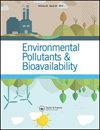Pyrogenic temperature affects the particle size of biochar-supported nanoscaled zero valent iron (nZVI) and its silver removal capacity
Q3 Chemical Engineering
引用次数: 10
Abstract
Abstract Particle size of nanoscaled zero valent iron (nZVI) in nanocomposites can be affected by support materials. In this work, nZVI was supported by bamboo-derived biochars produced at 450 °C (BBL) and 600 °C (BBH). Total iron (Fe) contents were 14.4 and 11.9% for nZVI immobilized in BBL (nZVI/BBL) and BBH (nZVI/BBH), respectively. The resultant nanocomposites were characterized by transmission electron microscopy (TEM), X-ray diffraction (XRD), and scanning electron microscopy/energy-dispersive X-ray analyses (SEM/EDS). The nZVI was successfully embedded in biochar pores and surfaces as confirmed by SEM/EDS and XRD. TEM revealed that particle sizes of nZVI in nZVI/BBL and nZVI/BBH were roughly 26 and 40 nm, respectively. The Ag+ sorption isotherms (25–300 mg L−1 Ag+) suggested that 1 kg of nZVI in nZVI/BBL and nZVI/BBH removed as much as 745.5 and 534.5 g Ag+, respectively. The results suggested that Ag+ removal capacity was related to particle size of nZVI, which was also affected by pyrogenic temperature.生热温度影响生物炭负载纳米零价铁(nZVI)的粒径及其除银能力
摘要纳米零价铁(nZVI)在纳米复合材料中的粒径会受到载体材料的影响。在这项工作中,nZVI由在450°C(BBL)和600°C(BBSH)下生产的竹衍生生物炭支持。固定在BBL(nZVI/BBL)和BBH(nZV/BBH)中的nZVI的总铁(Fe)含量分别为14.4%和11.9%。通过透射电子显微镜(TEM)、X射线衍射(XRD)和扫描电子显微镜/能量色散X射线分析(SEM/EDS)对所得纳米复合材料进行了表征。通过SEM/EDS和XRD证实,nZVI成功地嵌入了生物炭的孔和表面。TEM显示,nZVI/BBL和nZVIBBH中的nZVI的颗粒尺寸分别约为26和40nm。Ag+吸附等温线(25–300 mg L−1 Ag+)表明,在nZVI/BBL和nZVI/BBH中,1 kg的nZVI分别去除了745.5和534.5 g Ag+。研究结果表明,nZVI对Ag+的去除能力与粒径有关,同时也受热解温度的影响。
本文章由计算机程序翻译,如有差异,请以英文原文为准。
求助全文
约1分钟内获得全文
求助全文
来源期刊
CiteScore
1.62
自引率
0.00%
发文量
0
审稿时长
1 months
期刊介绍:
Chemical Speciation & Bioavailability ( CS&B) is a scholarly, peer-reviewed forum for insights on the chemical aspects of occurrence, distribution, transport, transformation, transfer, fate, and effects of substances in the environment and biota, and their impacts on the uptake of the substances by living organisms. Substances of interests include both beneficial and toxic ones, especially nutrients, heavy metals, persistent organic pollutants, and emerging contaminants, such as engineered nanomaterials, as well as pharmaceuticals and personal-care products as pollutants. It is the aim of this Journal to develop an international community of experienced colleagues to promote the research, discussion, review, and spread of information on chemical speciation and bioavailability, which is a topic of interest to researchers in many disciplines, including environmental, chemical, biological, food, medical, toxicology, and health sciences.
Key themes in the scope of the Journal include, but are not limited to, the following “6Ms”:
Methods for speciation analysis and the evaluation of bioavailability, especially the development, validation, and application of novel methods and techniques.
Media that sustain the processes of release, distribution, transformation, and transfer of chemical speciation; of particular interest are emerging contaminants, such as engineered nanomaterials, pharmaceuticals, and personal-care products.
Mobility of substance species in environment and biota, either spatially or temporally.
Matters that influence the chemical speciation and bioavailability, mainly environmentally relevant conditions.
Mechanisms that govern the transport, transformation, transfer, and fate of chemical speciation in the environment, and the biouptake of substances.
Models for the simulation of chemical speciation and bioavailability, and for the prediction of toxicity.
Chemical Speciation & Bioavailability is a fully open access journal. This means all submitted articles will, if accepted, be available for anyone to read, anywhere, at any time. immediately on publication. There are no charges for submission to this journal.

 求助内容:
求助内容: 应助结果提醒方式:
应助结果提醒方式:


